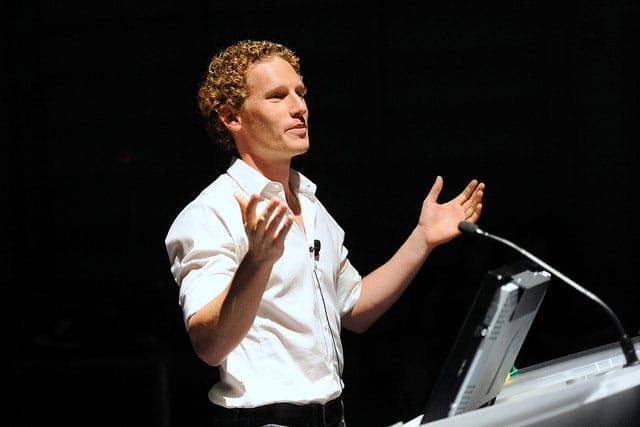On May 6, Chicago-area alumni from Wharton and Penn benefited from Wharton marketing Professor Jonah Berger sharing key insights from his 2013 best-selling book Contagious: Why Things Catch On. The group was excited to access the latest thinking from Wharton and to continue our lifelong learning.
The in-person opportunity to interact with Wharton faculty provided two sources of value for alumni: (1) It cut through the clutter of messages we are exposed to daily and served as a filter for quality of content; and (2) It helped keep us abreast of leading-edge thinking.
Berger’s polished, lively and “contagious” talk was peppered with relevant case studies. We learned about why Cheerios has more buzz than Walt Disney, which may seem obvious after the explanation of trigger points, but not straightforward at first guess. Disney World is an exciting destination for many families; however, it is something that people don’t talk or think about very frequently. By comparison, the bright yellow Cheerios box is triggered each day when people eat breakfast. Most Americans still eat breakfast at home, despite our on-the-go lifestyles, and Cheerios is a popular breakfast cereal. As Berger explained, most social media mentions of Cheerios occur in the morning. This is a good example of how a frequent trigger, like eating breakfast, drives word of mouth.
Another fun case was Blendtec; grinding an iPhone is not only absurd, but also extremely funny and memorable (see the video above). Many Wharton alums have probably seen one of the famous “Will it Blend?” videos from Blendtec. The video series has received more than 300 million views, an excellent example of contagious, word-of-mouth content that serves a marketing purpose; the videos show how Blendtec blenders are very powerful and can blend almost anything, including iPhones, marbles and more.
The key takeaways were the importance of word-of-mouth marketing and the distillation of six essential elements that promote viral, word-of-mouth messages. Berger has coined an acronym for these elements: STEPPS.
• The first “S” stands for social currency (we talk about things that make us look good).
• “T” stands for triggers (as per the Cheerios example).
• “E” stands for emotion (and not all emotions are the same for sharing).
• The first “P” stands for public.
• The second “P” stands for practical value (for example, the rule of $100 in promotional pricing).
• The second “S” stands for stories.
Berger structures his book around this framework, with a separate chapter for each element.
The event was co-sponsored by the Penn Club of Chicago, the Wharton Club of Chicago and the Union League Club. It drew a crowd of 215 to the Union League Club of Chicago, with more than 75 books sold on the spot.
Such lunch events have always been a winning combination for Chicago-area alumni, as it was in April 2013, when Adam Grant, Wharton Professor of Management and the Class of 1965 Chair, shared his insights from his book Give and Take to enthusiastic response in the same venue as part of the club’s Authors’ Series.
Beyond the content, in-person events also provide a forum for like-minded people to come together, share interests and connect in person.
Moving forward, Chicago-area alums are eagerly anticipating the possibility of hearing David Bell, Wharton’s Xinmei Zhang and Yongge Dai Professor, speak about his soon-to-be-released book, Location Is (Still) Everything: The Surprising Influence of the Real World on How We Search, Shop, and Sell in the Virtual One. The book, scheduled for release next month, features research on Wharton alumni-founded companies such as Warby Parker.
We want to offer a big thank you to Wharton and personally to professors Berger and Grant for making the trip to the Windy City, and for serving as excellent ambassadors for Wharton and Penn.

—Michal Clements and Luca Ottinetti
Michal Clements, WG’89, is a market strategy consultant and co-author of the book Tuning Into Mom: Understanding America’s Most Powerful Consumer.

Luca Ottinetti, WG’89, is the managing director of Great Prairie Group. He began his career in strategy at Bain & Company, followed by several years as principal at A.T. Kearney before running his firm.


























